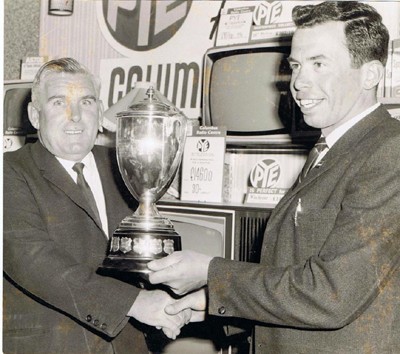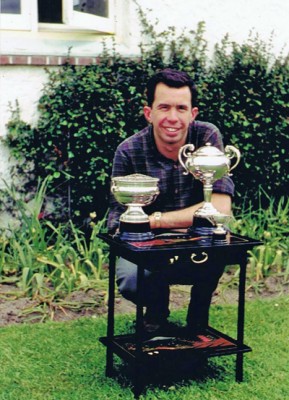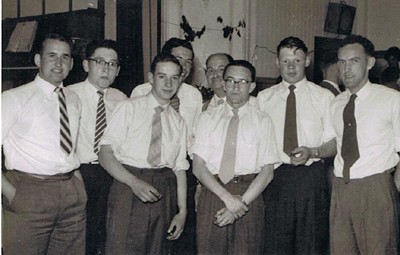What Is This Thing Called DX? (to a well known tune)
By Sutton Burtenshaw
PROLOGUE. Some Years Earlier.
While still at Primary School, a coil with a ‘thingy’ in the middle and a few lugs on the outside found its way into our household. With the aid of headphones I spent an hour or so each night for some months listening to a radio station on the medium wave band via a lead-in that dad & I hooked up to the main house antenna. In those days almost every house had a very high antenna to get reasonable reception above the electrical noise of the old Invercargill Tramway dc system. Ours was no exception with former American redwood yacht spars joined halfway, probably reaching close to 12m and guyed at three positions. Wire length would have been approx 24 meters and our house was 500 to 600m from the tram lines! Others living closer had much higher antennas. After what seemed a relatively short period of time my listening was cut short by a set malfunction. A close relative who as it turned out owned a ZC1 arrived one day with a soldering iron, a diode of some sort and a few bits of wire (“just in case”). The result being that I could no longer hear my medium wave station but lo and behold there was a Radio Australia shortwave station, nothing else. That was the end of that as far as I was concerned and the set was consigned to a box out of sight. My secondary schooling at Southland Technical College started a couple of years later and I sometimes bought a milkshake at the little milk bar/grocery shop just along in the next block of Tay Street. There was a sign on one wall inside the shop pronouncing, “New Zealand Radio DX League”. The couple who operated the shop seemed to be very obliging and it didn’t take me long to sum up the courage and ask, “What does the Radio DX League do?” OK, you guessed right, the shop was operated by Mervyn and Netta Branks and after explanations were completed I was sold on the hobby, BUT, there was a problem, time. I had just started a three piece dance band, was also learning a second instrument at school and of course there was homework to consider. The years following saw me enter an apprenticeship, so no dxing was done for quite some time.
1956 Onwards.
Southland Branch records show it was September 1957 when I joined the NZRDXL however the first logging in the book is 11th March 1956 and the station is HER-4 Berne Switzerland 9535 KHz and was heard on the family Philco table model radiogram. Not many stations were logged till 1957 when I started to really get the bug and found I could hear American stations on the Medium Wave band, the first of those being KXEL Waterloo Iowa 1540 KHz. Wow, what a buzz. At this period of time I was really doing a balancing act. Firstly, the family radiogram was in the family kitchen and I could not use it for dxing when a serial/play/comedy act was being aired. Secondly, I was in a country dance band and as well was the leader of a small city group that had week night practices also. All this and an apprenticeship! When I look back now, I wonder why I took on so much. Anyway I did find some time to dx. We in Southland were very fortunate in having Mervyn Branks foremost in our ranks for medium wave dx. Merv had negotiated permission to erect a small listening post in the sand hills beside the rocky south coast of the South Island at Riverton. This area is known as Riverton Rocks. The listening post itself was constructed from piano cases and was clad in flat galvanised iron; the type corrugated iron was shipped to NZ in. This listening post affectionately called the “6 x 3” was actually six foot by three foot and was approximately five foot high. Merv had installed a rotary terminal and so could select the antenna for the direction he wanted to listen to. The antennas which bisected the globe were in some cases several hundred feet long and mostly six to nine feet high. No, contrary to one wags belief, he was not farming Giraffes. Many of our branch members could be found there with Merv, Alex Allan and Eric McIntosh, experiencing the delights of listening in a noise free location and I was no exception, for after a dance closed down for the night, instead of driving back to the city I would turn up at the 6×3 to either be greeted by several dxers complete with wide grins, or sometimes loud snoring that indicated bad conditions. Usually I would do my own snoring at our family ‘crib’ (bach) at Taramea Bay just a short distance away. Fortunately, having a bedroom to myself at home in Invercargill I was able to set it out as a listening shack and resurrected an old Philco cathedral model radio and installed it complete on a cast off commercial desk. Now I was in business hearing stateside stations from home. There was great camaraderie among the Southland Branch members and over the years I have dxed with Neville Ross at (sometimes in) the Waikiwi swamp, Keith Robinson at Kapuka/Waituna, Ray Crawford and Bill Marsh Jnr at Otatara and Trevor Service and Eddie McAskill at Awarua Bay. Little did we know then what was going to be available in a few years out on the Peninsula? 1959 saw a change of scenery for me upon moving to the Petone area. Oh dear, real rowdy conditions both vocal and electrical while living in a workers camp! However I managed to find a seven tube Phillips that gave our two man hut less area to move in. When my roommate was away visiting relations I was able to listen on shortwave. I joined the Wellington Branch and met John Miller (former Southlander and Utility listener), Robin Bromby, Pat McRodden and Jim Butler. Pat who lived at Nae Nae had a quite small garden shed which did not have much gardening equipment in it but there was quite a bit of radio gear there. Jim was staying with Pat and his wife Frankie during the week and quite often the three of us could be found dxing on two sets, my Phillips and Pat’s Hammarlund HQ 120X. Boy, did I look longingly at that receiver. At the end of that year I headed back to Southland and didn’t take long to get back into medium wave. One day a letter arrived from Pat McRodden offering his Hammarlund for sale which I accepted very quickly indeed. He had bought an SP600. I was pretty darned pleased with myself for owning that receiver and got Bill Marsh Snr to check the alignment after what I imagined would have been a bumpy train ride down south to Invercargill. However soon after the wanderlust returned and I was off to another North Island men’s camp, this time in Taupo. DX was not even tried for there but I did have a few long weekends back down with Pat and Jim in the Hutt Valley. 1962 saw me back in Southland experiencing the delights of medium wave and also meeting one or two “new” dxers, one being Ray Crawford. Later on when building my new house Trevor Service and Ray Crawford were my electricians and Ray with his younger brother Allan (soon to be a branch member) working on the house linings too. Ray & I would be nailing gib-board from waist high up while Allan was doing the same job below that. At the back of the house and approx 320ft away was a very tall tree. We didn’t try to climb its full height but its direction was West/North/West in other words the antenna would be broadside on to USA. How fortuitous. I had not even given the tree a glance when buying the section. When I look through my logbooks I see many entries at a time when the US stations were signing on in our evenings with either The Star Spangled Banner or a rooster crowing and sometimes with both. The beauty of that location being I could dx in a comfortable chair in our lounge. In the mid sixties the Hammarlund was showing the signs of prolific use so a visit to Bill Marsh Jnr resulted in him converting the power supply to 240v. While I could hear the odd Peruvian and Colombian at home, I would need to travel to the Tiwai Peninsula to hear more from other South and Central American countries, and also try to learn a smattering of Spanish and Portuguese.
Best DX heard at either home; (apart from West & Central 250watters)
WHSL Wilmington North Carolina 1490Khz 250w @ 7.27pmNZDST (0627UTC)
Most Enjoyable;
WNEU Wheeling West Virginia 1600 KHz 5000w @ 10.00pm NZST (1000UTC) This was a sign on with a rooster crowing. The morning announcer phoned me after receiving my report, had me on air and “played the rooster” again a couple of times but unfortunately there was no reception at that time.
Note about the Hammarlund;
This receiver was labelled “HQ 120” but the Amateur Radio operator that lived next to Pat McRodden, and worked at Colyer & Beale, informed us that because the receiver was a “rack & panel” model, it was designated “X”. Hence my reference to Hammarlund HQ 120X. Now, looking back through vintage paraphernalia I’m not sure that holds true as various HQ’s that were obviously shelf or table models have been labelled “X”.
And then there was “Tiwai”;
Sometime in the early 1970’s Southland Branch member Wyn Machon a New Zealand Aluminium Smelter employee, mentioned to Ray Crawford, another NZAS employee, he had found a shearing shed and a house on a farm bought and used by NZAS to monitor any fallout from the smelter. The facilities which were not inhabited were located about six plus klicks from the main road and were devoid of any electricity service. Ray & Wyn negotiated permission to “try out” the area and Ray & I set up an antenna from the shed to the house. We used my Phillips table model dry cell battery radio. Upon connecting the antenna and turning the radio on, we were met with dead silence. “oh no the battery must be flat!” But when the tuning cap was moved there were stations everywhere, and between each station there was no noise whatsoever. What a great place to dx. The rest of the Tiwai story is not really mine to describe as others from within the branch will have different tales to tell of their experiences both in helping to put the listening post together and the many sojourns to dx on the Tiwai Peninsula.
Members
Southland Branch members who really taught me just what DX was all about and the camaraderie that goes with it.
Medium wave………..Merv Branks, Eric McIntosh & Keith Robinson.
Shortwave……………. Arthur Cushen & Alec Allan.
Photos
I never did own a camera in those early years and any photo’s I have, but taken by others, seem to be already included in related articles.
Afterlife
In the late 1970s after shifting house for family expansion, I quickly found because of city electrical noise in the new area there was not the same opportunity to dx the Broadcast Band. In fact most night’s Australian signals were not heard till around 9.30-10.00pm! Where were the stateside signals? What to do next? I studied to become an Amateur Radio Operator and became licensed in 1980 and soon found the dx opportunities in this form of the hobby.
But wait, there’s more!
From the mid to late 1950’s, Inter-branch competitions were instigated. Using a scoring system branches were allotted points based on members verifications received on both the Broadcast and Shortwave bands. There were cups/trophies donated by generous sponsors. The Broadcast Cup was known as the Albert Stanton Cup, whereas the Shortwave Cup was called the Hope MacGregor Cup. There was also an aggregate cup and it was known as the Columbus Trophy. All these trophies were won at times by our Southland Branch. In fact a couple of photos have been unearthed while I was writing this epistle. Here I am proudly accepting the Columbus Trophy on behalf of the Southland Branch from Don Cambridge, the then manager of the Columbus Radio Centre in Invercargill.
Below we see both the Albert Stanton Cup and the Hope MacGregor Cup.
In the photo above which is from 1958 we find a ‘DXer’s Rogues Gallery’. From left to right: Derek Howie, Brian Bellett, Neville Ross, Sutton Burtenshaw and Mervyn Branks both partly obscured, Des Frampton, Trevor Service and Frank Tod.
What is this thing called ‘DX’? It’s the ‘Love’ of listening to radio stations in far off lands.
Sutton Burtenshaw
June 2015






